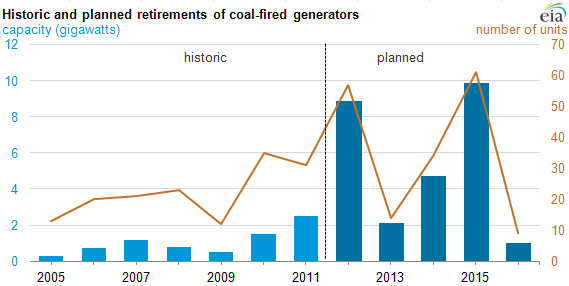National Geographic has a post on the shift in the USA to cleaner Natural Gas and the rise of coal exports.
The reality is it is hard for European power producers to pass on a $9 megawatt-hour difference in profit margin if they use coal vs. natural gas.
European utilities are now finding that generating power from coal is a profitable gambit. In the power industry, the profit margin for generating electricity from coal is called the "clean dark spread"; at the end of December in Great Britain, it was going for about $39 per megawatt-hour, according to Argus. By contrast, the profit margin for gas-fired plants—the "clean spark spread"—was about $3. Tomas Wyns, director of the Center for Clean Air Policy-Europe, a nonprofit organization in Brussels, Belgium, said those kinds of spreads are typical across Europe right now.
The article has lots of data like the drop in US coal powered electricity from 50% to 37.4%.
The reason is clear: Coal, which in 2005 generated 50 percent of U.S. electricity, saw its share erode to 37.4 percent in 2012, according to EIA's new short-term energy outlook. An increase in U.S. renewable energy certainly played a role; renewables climbed in those seven years from 8.7 percent to 13 percent of the energy mix, about half of it hydropower. But the big gain came from natural gas, which climbed from 19 percent to 30.4 percent of U.S. electricity during that time frame, primarily because of abundant supply and low prices made possible by hydraulic fracturing, or fracking. (Related: "Natural Gas Stirs Hope and Fear in Pennsylvania" and interactive, "Breaking Fuel From the Rock")
And points to other sources like the US Energy Information Associations data that 27 gigawatts of coal-fired capacity to be retired in 5 years.
27 gigawatts of coal-fired capacity to retire over next five years
Source: U.S. Energy Information Administration, Form EIA-860, "Annual Electric Generator Report."
Note: Data for 2005 through 2011 represent actual retirements. Data for 2012 through 2016 represent planned retirements, as reported to EIA. Data for 2011 through 2016 are early-release data and not fully vetted. Capacity values represent net summer capacity.
Plant owners and operators report to EIA that they expect to retire almost 27 gigawatts (GW) of capacity from 175 coal-fired generators between 2012 and 2016. In 2011, there were 1,387 coal-fired generators in the United States, totaling almost 318 GW. The 27 GW of retiring capacity amounts to 8.5% of total 2011 coal-fired capacity.
